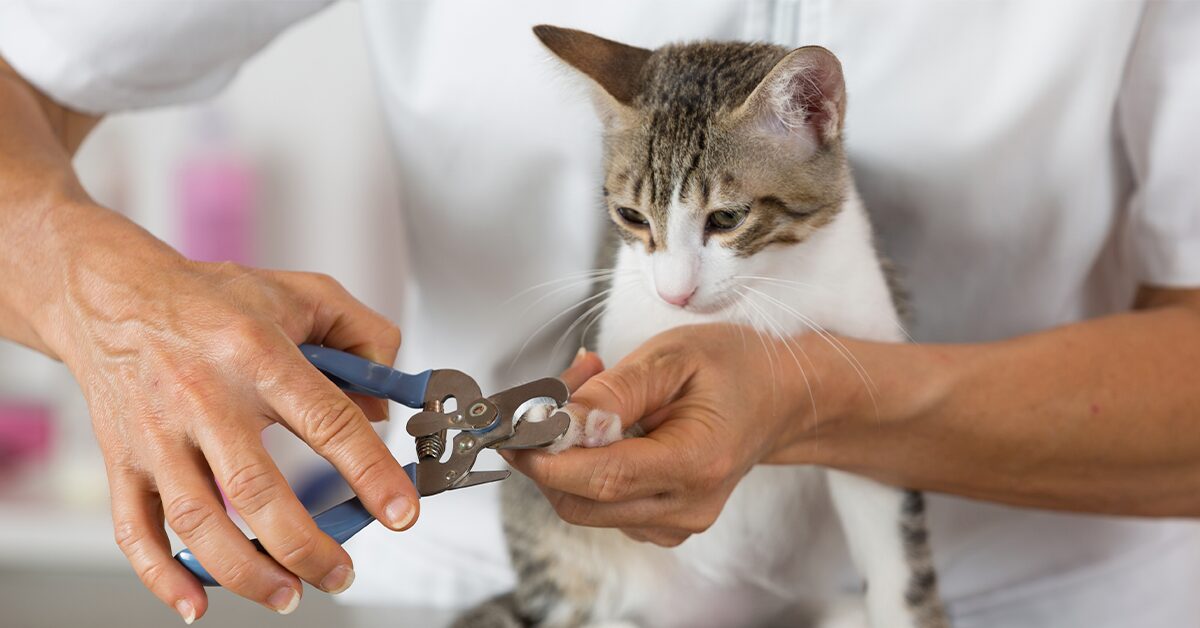Whether you’ve brought a cat into your home for the first time, or you’re a long-time cat owner, the thought of trimming your cat’s nails can be intimidating. Although some cats may not object to a feline manicure, others may be a little hesitant.
Regardless of where your cat stands, trimming their nails keeps them happy and healthy. Not only can it prevent overgrown nails and infections, but it can also help protect your furniture, carpets, and other surfaces in your home from harsh scratches.
Here, we’ll teach you how to trim your cat’s nails step by step, plus offer some additional tips to keep in mind as you go about the trimming process.
1. Prepare ahead of time
Learning how to trim your cat’s nails isn’t always simple, so preparation is essential. If you can, you’ll want to introduce your cat to nail trimming early in life. This will allow your cat to become accustomed to the process as they grow, making it easier for you to trim their nails on a regular basis.
According to the ASPCA, cats should have their nails trimmed every 10 days to two weeks. Of course, this timeline may vary from cat to cat – cats that spend a lot of time outside or frequently use a scratching post may naturally wear their nails down and not need trimming sessions as often.
To help prepare your cat for their nail trimming, start by slowly introducing them to different parts of the process. You can touch your cat’s foot and paw pad, exerting some pressure as if you were going to trim their nails, even without the clippers, to help them get used to the feeling.
You can also desensitize your cat to the sound and feel of the nail clippers by using them or touching them to your cat’s feet without actually trimming any nails. Through these actions, you can reward your cat with treats so that they have a positive association with the experience.
2. Get the right tools
The next step in trimming your cat’s nails is making sure that you have the right tools. As you might expect, the most important tool you’ll need is a pair of cat nail clippers. There are several types of nail clippers that you can use to trim your cat’s claws, so you might try a few different options and decide which type works best.
Here are some of the most common types of nail clippers:
- Scissor clippers: These clippers are like a small pair of scissors, with two blades that come together to cut the nail.
- Guillotine clippers: With guillotine clippers, the tip of the nail goes through a hole, and a blade slides up to cut the nail when the handle of the clippers is squeezed.
- Human nail clippers: You can also use human nail clippers on cats, although you’ll want to turn these sideways to cut the nail in the best way.
Additional tools you might find useful:
- Treats: It’s good to have some treats on hand to distract and reward your cat.
- A towel or blanket: Your cat may feel more comfortable in a towel or blanket while their nails are being trimmed.
- Styptic powder or styptic pencil: This antiseptic agent can stop bleeding if you accidentally cut too close to the quick (where the nerves and blood vessels are) and is available from pet retailers in-store and online.
- An extra set of hands: It may be beneficial to have a friend or family member there to help you with trimming sessions.
3. Get your cat situated
Now, you should be ready to begin the actual nail trimming process. To get started, you want to find the position that will be most comfortable for your cat while you trim their nails.
Ideally, your cat will allow you to trim their nails on a couch or bed, without the need for much restraint. Some cats, however, may be a little more resistant, and you’ll have to get creative.
Some cat owners hold their cat over their shoulder while another person clips their nails, others trim their nails while a family member holds the cat in their lap, and some even find that gently wrapping the cat in a towel or blanket can help them feel more soothed while getting their nails trimmed.
If all else fails and your cat is still resistant, you may want to enlist the assistance of a professional, like a groomer or veterinarian. They can show you techniques to help with the cat grooming process or even trim your cat’s nails themselves.
4. Take the paw and expose the nails
Once you have your feline friend in a comfortable position, you should take the nail clippers in your dominant hand and your cat’s paw in your non-dominant hand. You’ll want to gently squeeze or put pressure on your cat’s toes, one at a time, to expose their retractable claws.
Once your cat’s claw is exposed, you’ll see a white part and a pink part of the nail. The pink part of the nail is the quick, which again, is where the blood vessels and nerve endings live. You want to pay attention to where the quick begins, because if you hit the quick, your cat may bleed.
If your cat has light-colored claws, however, it should be fairly easy to distinguish the white part of the nail from the pink part of the quick. Cats with dark-colored claws can be a little more difficult. According to the Washington State University College of Veterinary Medicine, trimming in several small cuts can be helpful for animals with dark claws.
5. Trim the claws
With your cat’s claw exposed, position the nail clippers so that they are cutting top to bottom – not side to side – as this will help prevent any splintering of the nail. You can snip the tip of each nail individually, going slowly and carefully to make sure that you don’t hit the quick.
Even if your cat has lighter claws, you should still be cautious and make several smaller cuts as opposed to starting with one large cut. If you do hit the quick and draw blood, use a styptic pencil or powder to help stop the bleeding.
Repeat this trimming process on all of the nails on your cat’s paws, and don’t forget about the dewclaw, the nail on the inner side of each foot. These claws can grow into your cat’s foot if they get too long, so you want to make sure that they’re properly trimmed.
As for the claws on your cat’s back feet, many cats wear these nails down on their own and are less likely to need trimming on these paws. Although, you can still clip them if you feel it’s necessary.
Extra tips for trimming a cat’s nails
As the saying goes, practice makes perfect – and the more you trim your cat’s nails, the more comfortable you (and your feline friend!) will become with the process. To help you as you go along, you can keep these tips in mind:
- Create a schedule. Creating a schedule for nail trimmings helps your cat adapt to the experience. Additionally, keeping it consistent is a great way to prevent possible health issues.
- Be patient. All cats are different and what works for one cat may not work for another. Be patient with your cat and experiment with the things that will work best for them. You may only be able to clip a few nails the first time – but you’ll be trimming like a pro in no time.
- Ask for help. Don’t be afraid to ask for help when it comes to trimming your cat’s nails. You can hire a professional groomer to either teach you how to trim your cat’s nails, or to cut them for you. You also can talk to your veterinarian about what they recommend for trimming nails and even visit the office if you need hands-on assistance.




